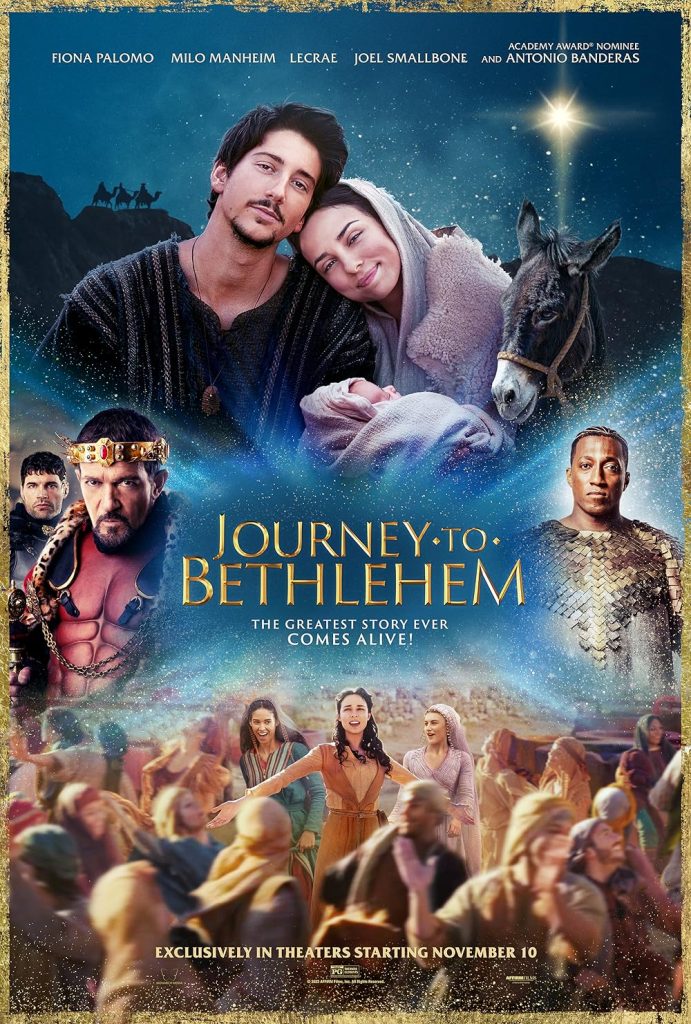In Review: Journey to Bethlehem
 by Ted Giese
by Ted Giese
Imagine the story of the Nativity of Jesus as a comedic live-action musical intended for a family audience. The plotline sprinkled with melodies covers the involvement of the Magi from the East, the interest of Herod the Great in the birth of the Child, the betrothal of Mary and Joseph, the visitation of the Angel Gabriel to the Virgin Mary and her miraculous pregnancy with the baby Jesus; and the couple’s journey to Bethlehem and the birth of Jesus there. That’s Adam Anders’ Journey to Bethlehem.
When adapting biblical accounts from Scripture, writers and directors often run into the same problem: there’s not much dialogue or details provided by Scripture—or at least not enough to make a modern drama, musical, or historical epic without adding to what’s already there. Certain genres lend themselves better to certain stories in the Bible; in that sense, a live-action comedy musical intended for a family audience is probably better suited for the Nativity story than Christ’s passion crucifixion. Even so, Christian filmgoers should hopefully expect that any liberties taken will nevertheless reflect the truth of Scripture and history in a way that doesn’t make light of their faith.
That’s where a comedic live-action musical starts to get dicey; not everyone will share the writer’s sense of humour. Of course, it isn’t impossible; many people young and old love the Veggie Tales children’s shorts and movies. A couple of years ago, The Star (2017) threaded this needle by telling the story of the birth of Jesus while incorporating the story’s animals into the plot—something common in Sunday School pageants. While The Star was light-hearted and took liberties, it somehow managed to do so respectfully, even while dealing with the central difficult topic of Mary’s virginity and her miraculous pregnancy.
Like The Star, Anders’ Journey to Bethlehem falls victim to the common sin of conflating the birth of Christ with the visitation of the Wise Men. St. Matthew writes in his Gospel, “Now after Jesus was born in Bethlehem of Judea in the days of Herod the king, behold, wise men from the east came to Jerusalem, saying, ‘Where is He who has been born king of the Jews? For we saw His star when it rose and have come to worship Him’” (Matthew 2:1-2). The key word here is “after.” Matthew makes it clear that the wise men came from the east after Jesus was born not when Jesus was born. The Gospel writer even notes, “And going into the house, they saw the child with Mary his mother, and they fell down and worshiped him” (Matthew 2:11); that’s “house” now, not “stable.”
This misrepresentation is a longstanding issue, encountered in everything from Christmas cards to nativity sets, to films and television shows, mainly because the birth of Christ in the western Church’s liturgical calendar begins the 12 days of Christmas and ends with the Wise Men’s visitation on the 12th day (Epiphany). The film’s director, Anders, knows that the Magi didn’t arrive at the birth of Jesus but accepts the creative license that puts them at the nativity. This is not ignorance of the facts of the Scriptural account, it’s willful misrepresentation. That isn’t to say Anders isn’t passionate about the project or God’s Word. Neither does it mean he doesn’t have good intentions. What it does mean is that he’s willing to fudge details to please his intended audience.
What it does mean is that he’s willing to fudge details to please his intended audience.
In his film, Anders makes melodramatic adaptations: Herod the Great is a two-dimensional over-the-top mustache-twirling villain with no human nuance in his paranoia; Mary and Joseph are embroiled in a Disney-like prince and princess romantic comedy, Bollywood-style courtship; and the three Wise Men serve as slapstick lowbrow comic relief. The script might have been better served as an animated feature because animation invites a greater degree of suspension of disbelief.
The Magi are particularly difficult to put up with. In addition to conflating their arrival with the birth of Jesus, the Wise Men manage to squeeze in a joke about smelling like sheep dung, further conflating them with the shepherds watching their fields at night. How so? Anders has them hiding from Herod near Bethlehem disguised as shepherds! So, it is them—not the actual shepherds—who are greeted by the angels in the hills outside Bethlehem.
While the characters of the Virgin Mary and Joseph end the film well, and the actors do a fine job with the material they are given, the characters’ origins are problematic. Mary is presented as a stubborn teenager at odds with her parents over her betrothal—desiring instead to be a school teacher like her father with no interest in motherhood. She even sings lyrics like, “Maybe married means that I’m kissing all my dreams goodbye,” scornfully describing her future as “keeping house and making babies, going shopping, all the chores.” Joseph meanwhile is portrayed as an incorrigible flirt who, even though he knows he’s engaged to be married, inadvertently attempts to strike up a romance with Mary in the town’s market not knowing she is the one he’s arranged to marry. These additions to the Scriptural account are intended to provide drama and romance but end up calling into question the integrity of the real biblical personages of Mary and Joseph. Developing a romance story between them could be a way to produce dramatic tension in the film—but the question is how best to do so while remaining faithful to the Scriptural account. Thankfully, the two are not shown kissing until after the birth of Jesus.
One interesting story choice was to include the first son of Herod the Great, Antipater. Historically, he died right around the birth of Christ Jesus in 4 A.D., as ordered by his father. Here Anders supposes that Antipater’s death could have been entangled somehow with the birth of Jesus. Although an interesting idea, it would be better explored in a more dramatic film.
A laundry list of assumptions permeates Journey to Bethlehem. Viewers with a high view of Scripture will find it hard to take. On the other hand, for families wanting something to watch that isn’t filled with violence and foul language, Anders’ film delivers. Journey to Bethlehem is a light-hearted, if extraordinarily silly, account of the birth of Christ. The question is: are families well-served by such a rendition of the biblical account? As Christmas approaches, or in years to come as Christmas rolls around again, Anders’ film ought not substitute for attending a faithful church to hear the biblical account read and preached, and to sing together the beloved Christmas hymns of the Christian faith.
It’s ill-advised to tell tall tales when recounting the Bible, especially when liberty is taken even with the details explicitly presented in Scripture.
If families do choose to see the film, they should sit down together afterwards to read Luke 1:26–56; 2:1–21 and Matthew 1:18–25; 2:1–18. That will give you plenty to discuss about what the film got right and what it made up. It’s ill-advised to tell tall tales when recounting the Bible, especially when liberty is taken even with the details explicitly presented in Scripture. Holding more closely to the story as it is actually written would go a long way to avoiding misconceptions about the story.
To be sure, adaptation inherently has its limitations and challenges. And while a high degree of fidelity may not be as important when it comes to adapting works of fiction, there is more at stake when it comes to adapting historical events and religious texts. The fact that Journey to Bethlehem is a comical family musical doesn’t excuse its misrepresentations of the Scriptural account, regardless of the filmmaker’s intentions. Sadly, it’s quite possible for someone to mean well and be wrong even when it comes to sharing their Christian faith.
Those who think this is a strict take on a project produced with good intensions should remember what St. James writes: “Not many of you should become teachers, my brothers, for you know that we who teach will be judged with greater strictness” (3:1). On the other hand, we can take comfort from what he says immediately after that: “For we all stumble in many ways. And if anyone does not stumble in what he says, he is a perfect man, able also to bridle his whole body” (James 3: 2). The sins of Journey to Bethlehem are forgivable and something to learn from.
What about the music? Anders is joined by his singer/songwriter wife Nikki Anders and composer Peer Astrom in creating the music for Journey to Bethlehem. Astrom previously worked as the composer for the 2012 musical Rock of Ages and is credited as a producer of featured songs in eighty-eight episodes of Glee. For those familiar with these projects, Journey to Bethlehem will provide few surprises. As might be expected the film occasionally incorporates a couple lines or a verse from beloved Christmas and Advent hymns like “O Come, O Come Emmanuel,” “Silent Night,” and “O Holy Night.” But the rest of the music is specifically crafted for the film. The strongest of these is “The Nativity Song” which shows a high degree of reverence for its subject while deftly incorporating hymn lyrics and new lyrics.
While some will enjoy Journey to Bethlehem because of its warm-hearted intentions, family friendliness, and musical flair, it is unfortunately hard to recommend. For families interested in diving into the Christmas story this year, they should be encouraged to read it together out of the Bible and join with their fellow Christians at church—and not at the movie theatre or streaming at home. This is yet another example of the Book being better than the movie.
 ———————
———————
Rev. Ted Giese is lead pastor of Mount Olive Lutheran Church, Regina, Saskatchewan, Canada; a contributor to The Canadian Lutheran, Reporter; and movie reviewer for the “Issues, Etc.” radio program. For more of his television and movie reviews, check out the Lutheran Movie Review Index.





